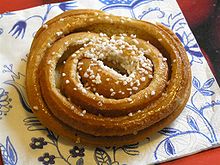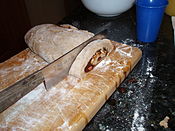Cinnamon roll
 A Finnish korvapuusti ("A slap on the ear") | |
| Alternative names | Cinnamon bun, cinnamon swirl, cinnamon snail |
|---|---|
| Type | Sweet roll |
| Place of origin | Sweden |
| Main ingredients | flour, cinnamon, sugar and butter |

A cinnamon roll (also cinnamon bun, cinnamon swirl, cinnamon Danish and cinnamon snail[1][2]) is a sweet roll served commonly in Northern Europe and North America. In North America its common use is for breakfast. Its main ingredients are flour, cinnamon, sugar, and butter, which provide a robust and sweet flavor. In some places it is eaten as a breakfast food and is often served with cream cheese or icing.[citation needed]
About
It consists of a rolled sheet of yeast-leavened dough onto which a cinnamon and sugar mixture (and raisins or other ingredients in some cases) is sprinkled over a thin coat of butter. The dough is then rolled, cut into individual portions, and baked or deep fried. In North America, cinnamon rolls are frequently topped with icing (usually confectioners' sugar based) or a glaze. In Northern Europe, nib sugar is usually used with a glaze instead of icing. Commonly in North America, these rolls are fried, glazed, and served as a variation of a raised donut.
In Sweden, the country of its presumed origin, the cinnamon roll takes the name of kanelbulle (literally: "cinnamon bun"), and October 4 has more recently started to be promoted as "kanelbullens dag" (Cinnamon Roll Day).[3][4] Swedish kanelbulle dough typically also contains cardamom (powder or buds), giving it a distinctive flavour. A German variety originating in Hamburg and its surroundings is the Franzbrötchen, a cinnamon pastry inspired by the non-cinnamon French croissant.
The size of a cinnamon roll varies from place to place, but many vendors supply a smaller size about 5 centimetres (2.0 in)* in diameter and a larger size about 10 centimetres (3.9 in)* to a side. The largest variety can be found in Finland, called Korvapuusti, where it can be up to 20 centimetres (7.9 in)* in diameter and weighing 200 grams (7.1 oz)*.[5]
The Finnish "Boston cake" is a "cake" made by baking cinnamon rolls in a round cake pan instead of baking them separately, so that they stick together to form a round cake.[6]
Varieties
Honey bun
A honey bun is a sweet roll similar to the cinnamon bun that is popular in the southeast United States. "A honey bun is a fried yeast pastry that contains honey and a swirl of cinnamon in the dough and is glazed with icing. According to legend, Howard Griffin of Griffin Pie Co. in Greensboro, North Carolina, developed the first honey bun in 1954. Flowers Foods acquired Griffin Pie Co. in 1983. Although the Greensboro bakery is now closed, honey buns remain a best-seller for Flowers."[7] Unlike cinnamon buns, which are generally the product of bakeries, honey buns are common convenience store and vending machine fare. Normally sold individually wrapped, alone or in boxes of 6 or more, they are a popular grab-and-go breakfast, eaten cold or heated in a microwave oven.
- Cinnamon rolls
-
A Norwegian skillingsbolle
-
A 'loaf' of raw cinnamon roll dough being cut into individual rolls prior to being baked
-
A cinnamon roll with glaze
See also
- Cinnabon - Bakery chain known for cinnamon rolls
- Chelsea bun - Confectionery made using a similar process
- Sweet roll
- Tahini roll
- Fig roll
- Tahinopita
- List of buns
References
- ^ The Free Dictionary. "cinnamon snail". Retrieved April 17, 2013.
- ^ Carlson, Jen. "Why The Cinnamon Snail Vegan Food Truck Is The Best Food Truck In Town". The Gothamist. Retrieved April 16, 2013.
- ^ "Kanelbullens Dag 4 Oktober". Kanelbullensdag.se. Retrieved 2010-06-04.
- ^ "Kanelbullar". Sweden.se. Retrieved 2013-03-25.
- ^ Korvapuusti in Finland
- ^ "Boston cake". Saunalahti.fi. Retrieved 2012-11-18.
- ^ "Mrs Freshley's - Varieties - Honey Buns". Mrsfreshleys.com. Retrieved 2012-11-18.



